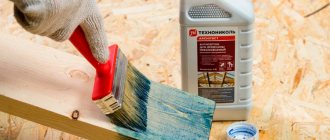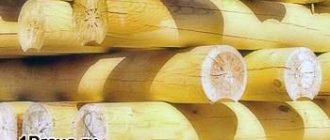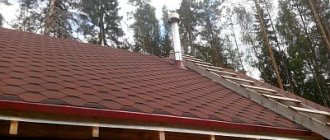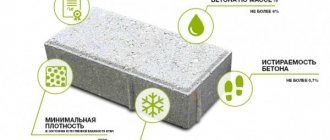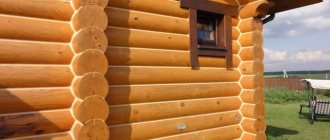To protect the tree from various types of insects, as well as to increase resistance to fire, antiseptics are used. You can always find ready-made mixtures on sale, but their cost is high, especially such a purchase hits the wallet when the goal is to saturate large objects. Therefore, you can prepare a wood antiseptic with your own hands. The process is simple, and acquiring the necessary ingredients is not difficult. Details on how to make an antiseptic will be discussed below.
Types of antiseptic compounds
Do-it-yourself antiseptic, or a ready-made one, has the function of protecting against any type of insects; it is advisable to impregnate the wooden material before the construction stage; according to GOST 20022.2, there are 18 types of protective treatment for wood, and antiseptic is one of them.
If necessary, antiseptic agents can get rid of insects that have already settled in the base of the tree. There are 4 types of these solutions:
- With a water base, they are intended for indoor treatment of premises where contact with water is not intended;
- With an oil base, they are used exclusively externally, for example, for impregnating fences and facades. They emit a pungent odor;
- Solvent-soluble, can be used inside and outside the building, petroleum products are used as a base; after impregnating the object with them, a reliable barrier from moisture is obtained;
- Combined, in addition to protecting against insects, they have the function of reducing the flammability of wood.
A do-it-yourself antiseptic, or a ready-made one, has the function of protecting against all types of insects; it is advisable to impregnate the wooden material before the construction stage.
Dependence of wood biostability on external factors
The resistance of wood material to biopests depends on many factors; during the construction and operation of a wooden house, it is important to provide optimal conditions for its protection. Putrefactive fungus affects not only lumber with natural moisture content, but also air-dry and semi-dry construction wood with a moisture content of 18 to 22%. To a greater extent, the activity of putrefactive fungus depends on the environment and the influence of external factors. The development of microorganisms is accelerated in conditions of high humidity, in swampy and low-lying areas; favorable factors for the development of fungus include:
- Constant moisture content of lumber exceeding 18%,
- Water flowing into the cracks between the crowns,
- Direct contact of the tree with moist soil,
- Ambient temperature from +5 to +35 degrees.
Rot most often affects walls facing north and lower crowns. The warm and humid climate promotes the activity of wood-boring insects, which use wood as a product for their livelihoods.
Experts note that the conditions for the development of fungus can be the most unexpected. For example, a house surrounded by a solid high fence is more susceptible to rotting due to insufficient ventilation.
Classification
There is a classification of such means, knowledge of which helps to understand which option should be chosen for a particular situation. The following types of products are distinguished:
- For internal processing, they must be harmless to the body;
- For external coatings, they must be resistant to pests, as well as ultraviolet radiation;
- Water-based, which are most often used for application indoors due to their safety for human health;
- Oil-based, they have an unpleasant odor, so they are applied outside the building, but are environmentally friendly;
- With a wax base;
- Contains solvents.
For external coatings, they must be resistant to pests, as well as ultraviolet radiation.
Recipe for salt-based impregnation
- The main substance used is sodium fluoride in the amount of 25 kg.
- The product is immersed in a container of 400 liters of water and diluted until smooth.
- Next, the log house is processed using a special apparatus for airless painting under a pressure of 200 bar.
- Simultaneously with processing, the top layer of wood is removed. Then the surface is sanded using a 40 flap wheel and a final treatment is carried out with oil, varnish or other means.
The advantages of salt-based impregnation include lower toxicity compared to aqueous solutions. The disadvantages are a lower degree of protection; ability to be washed off with water; the need to use additional coatings for fixation.
The use of synthetic impregnations is unsafe, especially for interior work. The substances included in the composition are toxic and flammable. To create an environmentally friendly wood treatment, it is recommended to use vegetable or natural beeswax. Wax impregnation is absolutely safe, gives the surface a pleasant aroma, makes it resistant to mechanical damage, imparts water-repellent properties, emphasizes the beauty and texture of the wood, and creates a beautiful matte finish with shine.
The solution consists of turpentine and wax, taken in a ratio of 1:2. To process food-grade wood products, oil is mixed instead of turpentine in a 2:1 ratio.
Antiseptic basis
The composition of wood antiseptic may include different components, but the most popular ingredients used in recipes are those described below:
- Copper/iron sulfate;
- Iodine;
- Zelenka;
- Bitumen;
- Silicon/sodium fluoride;
- Pastes with a clay base;
- Pastes with a biocidal base.
The composition of a wood antiseptic may include different components.
Selection and use of antiseptics
The entire history of the use of wood in economic activities is associated with the development of means of protecting it from biopests; antiseptic treatment refers to the treatment of wood with toxic compounds in order to destroy harmful microorganisms and insects. For these purposes, specially developed antiseptics are used. Antiseptic methods are available to mass developers; antiseptics for treating construction wood can be prepared with your own hands.
The choice of antiseptic for timber must be approached with caution; experienced craftsmen recommend using only proven antiseptics and not experimenting with their compositions. Strong components can cause chemical burns to wood and destroy the top layer of cellulose, which will lead to the formation of microcracks and peeling of fibers on the treated surface.
Nuances of antiseptic “handicrafts”
The quality of impregnation for wood with your own hands depends on the composition; it is also important to understand the features of the manufacture and use of the resulting substance. Therefore, the important points of this process will be described below.
The quality of do-it-yourself wood impregnation depends on the composition.
Pursued goal
Do-it-yourself wood impregnation must meet a number of requirements in order to fulfill its main purpose. There are several main functions required from it to obtain high-quality surface treatment:
- Creating a protective coating from natural influences if the item is used outdoors;
- When used in a humid environment - moisture resistance;
- Wood that will be transported in open transport;
- Wooden material from biological influences and pests.
Do-it-yourself wood impregnation must meet a number of requirements in order to fulfill its main purpose.
Possible ingredients
The result obtained and how well the solution will fulfill its purpose will directly depend on the chosen composition. For independent production of the mixture, the following components are selected as standard:
- Boric acid;
- Gasoline, diesel fuel;
- Bitumen mixture;
- Iodine/green stuff;
- Vitriol with copper or iron;
- Biocidal or clay pastes;
- Salt, soda.
A good and safe option is to prepare a mixture of water and salt; you can safely treat the surface inside a building with it.
A good and safe option is to prepare a mixture of water and salt; you can safely treat the surface inside a building with it.
How to prepare, apply
It is better to prepare an antiseptic at home from safe ingredients. Then the processing and the cooking process itself will be easier. To work you will need containers and mixing tools. If toxic elements will be used, ensure good ventilation in the room.
If toxic elements will be used, ensure good ventilation in the room.
Surface preparation
The item must be cleaned and degreased in advance (alcohol can be used, vodka will also work, but it is better to choose White Spirit). To clean particularly difficult stains, you can try using hydrogen peroxide; glycerin can also be used.
If the appearance of the item is important, then it is necessary to sand the wood for an even coating. It is also necessary to prime the surface; you can use a prepared antiseptic for this purpose, diluting it with a solvent - White Spirit, which can also be used for the degreasing stage.
If the appearance of the item is important, then it is necessary to sand the wood for an even coating.
Tips for applying impregnation
Before starting work, it is advisable to more thoroughly prepare the surface on which the composition will be applied. Clean from dust and other contaminants and sand. Pre-treat existing cracks with white spirit and prime with alkyd primer.
Long-handled synthetic brushes or felt rollers are ideal for applying oil liquid. Excess must be removed with a soft, lint-free cloth. Repeat the manipulation in 1-2 steps.
Thick antiseptics are applied with a regular paint brush, sponge or soft rag, or a lint-free roller, while liquid ones are best applied with a spray gun.
When performing work on impregnating wood with an antiseptic outdoors, it is necessary to take into account external factors. It is better to choose dry, calm weather for applying the product.
Designate a special area for work. Prepare in advance all the tools, personal protective equipment and buy the missing items.
Internal wood impregnation work is permissible in well-ventilated areas.
When purchasing lumber, give preference to wood species that are most resistant to the destructive effects of external factors. These include: ash, pine, oak, Siberian larch
If desired, you can also use an old method to protect wood, which practically eliminates costs - roasting or boiling in a saline solution .
You can also impregnate wood using traditional methods - birch tar, flax oil, pine resin mixed with crushed coal and salt.
Bitumen antiseptic
In addition to this substance, a solvent should be added to the product. You can use gasoline or diesel fuel. The latter will give the substance a high ability to penetrate into the structure of the material, but the process will take a lot of time. Gasoline does not require long soaking time, but will not penetrate as deeply into the wood.
First, the bitumen is heated over a fire and stirred periodically to remove all lumps. When foam appears, you can remove the solution from the heat, then add solvent to it, usually its amount is 20-30 percent.
The substance must be poured in small portions, and gasoline is added after the solution has cooled.
In addition to this substance, a solvent should be added to the product.
How to prepare the surface for processing?
Before antiseptic treatment, it is necessary to prepare the wood for application of the composition. This is done in several stages:
- Surface cleaning. First you need to remove all dirt or formations that have appeared during operation.
- Grinding. All roughness and surface irregularities are removed by grinding. This way the solution will better penetrate the wood texture.
- Degreasing. Helps completely remove grease and dirt accumulated on the surface. The surface is wiped with white spirit applied to a lint-free cloth.
This method of preliminary preparation is suitable both for processing with ready-made solutions and for those prepared independently. After this, you can begin applying the antiseptic.
Aqueous antiseptic solutions
Aqueous antiseptics are prepared quickly and safely. To make the composition, it is necessary to heat the water, where one of the selected elements will then be dissolved. Next we will look at working with different options.
Aqueous antiseptics are prepared quickly and safely.
Sodium fluoride
For this recipe you need to use 10-40 grams of this ingredient per liter of water. More components are used when they are going to cover an object outside the building. To work inside, you can limit yourself to 5 grams. In order to see which area has been treated during application, they resort to treating the wood with potassium permanganate, which is added in small quantities to the mixture; after drying, the color will disappear.
For this recipe you need to use 10-40 grams of this ingredient per liter of water.
Copper sulfate
This substance is used when dealing with an object buried in the ground. Add 1-2 kg of vitriol to 10 liters of water. You should know that a large amount of the substance will make the solution take a long time to dry, but also be more effective. Vitriol also leads to a change in the shade of the surface.
This substance is used when dealing with an object buried in the ground.
inkstone
This material promotes good pest control; it can remove insects from an already infected tree. But its decorative properties are poor.
For 10 liters, add 50 grams of vitriol, as well as 5 grams of potassium permanganate. Instead of potassium permanganate, a water-based pigment is added for visual perception.
This material promotes good pest control; it can remove insects from an already infected tree.
Why do you need to process wood?
Treating wood with antiseptics is necessary to protect against pests, bacteria, and mold. Putrefactive microorganisms can change the natural structure of wood fibers in a short time, and fungal spores leave dark stains that cannot be removed.
With constant exposure to moisture, mold appears on wooden objects, which leads to their destruction. Molds have a detrimental effect on human health, and when harmful ergot is first detected, radical measures must be taken.
This is what wood affected by fungus looks like. If proper measures are not taken in time and the harmful spores are completely destroyed, then in a short time mold will cover the entire wooden surface
Antiseptic agents have a general toxic effect on wood borers, putrefactive microflora and cause their death.
When exposed to an antiseptic, a protective anaerobic film is formed on the wood, which is unfavorable for the life of parasites, which also becomes a barrier to the penetration of moisture and oxygen. Therefore, a wooden product (chair, bed, bath, etc.), building (house, bathhouse) or structure (gazebo, summer bathhouse) will last longer.
There are different types of antiseptic impregnations for wood processing:
- Oil-based products are ideal for impregnating wooden facades, outbuildings, garden gazebos, fences, benches and more. These products prevent moisture from seeping into the wood and are excellent pest control. Oil solutions have a specific odor, are toxic, flammable and are not recommended for use in enclosed spaces.
- Wax . The direct purpose of wax-based protective mastic is to protect decorative wooden surfaces and products. The shelf life of the wax antiseptic reaches one year.
- Water based . Excellent for processing interior wooden building structures and facades. The advantage is the absence of toxicity, absolute safety, and the absence of a pungent odor. If the composition contains fire retardants, then this treatment gives the wood fire-resistant properties.
- Based on organic compounds . Organic non-oil products contain isotopes of sodium and phenol. When dry, they form a thin protective layer that protects the wood from the destructive effects of moisture and scorching sun.
Organic antiseptics can also be used outside buildings. After complete drying, it is necessary to open the surface with varnish or apply a layer of paint.
According to the type of protection, antiseptics can be used against rot and mold , and fire-bioprotection (with fire retardants).
Impregnations for interior and exterior use .
You can apply the antiseptic with a brush, but your hand movements must follow exactly the location of the wood fibers
Comprehensive protection of wood is provided by combined antiseptics . These products protect it from inflammation and moisture, and from damage by putrefactive microorganisms.
They contain copper sulfate, which helps disinfect wood, but at the same time changes its natural color.
When choosing organic means of protection, you must remember that they give the wood a dirty greenish tint, and rust forms when it comes into contact with metal.
Vegetable oils
You can use vegetable oils for impregnation - flaxseed and hemp. It is important to understand that they will change the color of the surface. The wood will “breathe” and retain its properties. To give the composition the best qualities, it is recommended to add burdock, elecampane, galangal or angelica root to flaxseed oil.
The wood will “breathe” and retain its properties.
Operating principle
To understand how antiseptic drugs work, you need to understand how infection spreads. When moisture gets in, some of the fibers die. Fungi eat these fiber structures. Mycelium is formed and the root system develops.
New fungi require new amounts of food. The amount of fiber used for nutrition is increasing exponentially. If there are suitable conditions (humidity, fresh air flows, maintaining optimal temperature, etc.), the wood dies in a fairly short period of time.
Resistance of wood to damage
Different types of wood have different resistance to rot:
- resistant to the spread of decay can retain their original properties for a long time. These include: oak, beech, walnut, hazel, larch, hornbeam, apple, cherry;
- medium-resistant ones retain their initial characteristics only in the initial period, then their wood is subjected to destructive microbiological effects. These are considered to be: spruce, pine, fir, aspen, linden;
- weakly resistant ones quickly undergo putrefactive processes. These include: birch, maple, alder;
- unstable species are characterized by the fact that rotting can occur on growing trees: aspen (central loose part), balsa, elderberry, acacia.
Features of the action of antiseptics
The work of antiseptics is based on several basic principles:
- treatment of wood from existing fungi and bacteria. The composition contains substances that prevent the spread of infection in the mass of the substance. Fungi die due to exposure to insecticides;
- deep penetration of drugs into the structure of the tree and clogging of existing pores. As a result, the spread of microflora inside is prevented;
- the formation of a protective film around a piece of wood. Access to moisture and air fibers becomes so limited that rhizoids (analogous to the root part) cannot form. Therefore, the fibrous part does not collapse or die. The film coating stabilizes the condition.
Treating the finished product with an antiseptic.
Apply with a regular wide brush.
Antiseptics for wood with deep penetration are characterized by the intensity of their effect on the porous structure.
Wax
The wax coating helps impart a moisture-resistant characteristic to the finish after the oil has been applied. You will need 100 grams of wax, 25 grams of rosin, 50 grams of turpentine.
Turpentine is chosen if you are preparing a wood antiseptic for outdoor use with your own hands. For application inside the room, linseed oil is used.
The wax base is melted in a water bath, rosin is gradually added. Mix the ingredients well and pour in the oil. After boiling, remove the container from the heat. It is important to immediately pour it into a metal container.
The wax coating helps impart a moisture-resistant characteristic to the finish after the oil has been applied.
Why do you need to treat wood with an antiseptic?
When a tree is cut down, the fibers in its structure begin to die. Such an environment becomes nutritious for fungi - saprophytes. They destroy wood and paint it in different colors: blue, red, yellow, green. In addition to fungal microorganisms, there are other threats:
- insect pests;
- high air humidity;
- precipitation: snow, rain.
Antiseptic treatment is a mandatory stage of working with wood. It protects against all of these negative factors and extends the life of wooden structures or cladding.
Other recipes
You can also prepare other types of antiseptic wood impregnations. For example, liquid glass in an amount of 1.4 liters is mixed with chalk and talc (they are taken in 200 grams each). The flammability of the material can be reduced by means of boric acid (take 4 grams), ammonium hydrogen orthophosphate (40 grams), and water - 400 mm.
You can also prepare other types of antiseptic wood impregnations.
What elements of a house or apartment should be treated?
The risk group includes wooden elements located in direct contact with the soil, foundation, walls of the building and an environment with a high level of humidity, which means that antiseptic treatment will be required for the following elements:
- parts of a wooden supporting frame;
- flooring, joists;
- wall partitions, interfloor and ceilings;
- lower crowns of log buildings;
- any other hidden wood elements;
General rules for application and processing
To obtain an even distribution of the composition, the application itself should be carried out correctly. Experts recommend adhering to the following operating rules:
- If liquid antiseptics are made, then spray with a spray gun; for thicker ones, choose brushes, rollers, or a sponge;
- For safety, the master must wear a respirator and protective clothing, gloves;
- Good ventilation is created inside the room.
For safety, the master must wear a respirator and protective clothing and gloves.
It is possible to make an antiseptic for wood yourself. The main thing is to decide on the components and carry out the process in compliance with safety measures. This is an economical option if large areas will be impregnated.
Conclusions and useful video on the topic
Recipe for preparing wood impregnation:
Detailed instructions for making impregnation for fire-bioprotection at home are in the following video:
Wood has always been in demand and people have invented various ways to protect it from pests and minimize the harmful effects of precipitation, high and low temperatures. You can use both purchased products and make your own using natural ingredients, most of which are available on the farm.
What antiseptic do you use? Share your recipe for the perfect impregnation, which is easy to prepare yourself - the comment form is located below. If you have questions about wood preservatives or application nuances, ask our experts and other site visitors.
What do you need protection from?
From rot
Wood, regardless of its species, is capable of absorbing moisture. With varying intensity, but getting wet leads to the appearance of mold (fungus) and the development of various bacteria.
From insects
Various wood-boring bugs can turn a tree into dust in a short period of time and furrow any part of the structure with tunnels. Moreover, they “work” regardless of the time of year, and there is no escape from them except to saturate the material.
From contact with the atmosphere
Changes in humidity and temperature levels lead to cracks appearing in the wood. And the stronger this influence, the more often you will have to do repairs. And ultraviolet light not only speeds up this process, but also leads to darkening of surfaces, which does not have the best effect on the appearance.
From the fire
Everyone knows that wood belongs to the class of combustible materials. Therefore, there is no point in explaining why protection from thermal influences is necessary.
When the question of the most effective means of fire-bioprotection is raised, one can often hear recommendations with reference to the “wonderful” imported means. And here, it seems to us, some clarification is required. In pursuit of bright labels and catchy names, we sometimes forget that during the Soviet era, our “chemistry school” was considered one of the best in the world.
It cannot be assumed that its traditions do not continue. Moreover, many advertised foreign formulations are based on our developments. How they got there (over the hill) is another question. But the fact remains a fact, and serious experts will not deny this.
Practitioners strongly recommend that when choosing compositions for wood processing, attention should first of all be paid to domestic products. The packaging may not be right, but the result is wonderful. Moreover, it is advised to focus on the drug’s compliance with State Standard No. 28815 of 1996.
How to understand what kind of composition this is? It is necessary to carefully study the code, consisting of letters and numbers. This is what you need to pay attention to first of all.
DIY wood antiseptic, recipe
Wood is especially susceptible to insect attacks in the spring, when they wake up, and also in the fall, when the bugs seek shelter before the onset of cold weather. Given this feature, it is important to treat the following elements with an antiseptic composition twice a year, namely:
- wooden fences;
- garden furniture and accessories;
- wooden elements of exterior decoration of the house.
Untreated wood will not last long and will deteriorate under the influence of sun, rain, and wind. In addition, the material loses its visual appeal and becomes fragile. Tint solutions can not only protect the material well, but also give it a better look.
Untreated wood will not last long and will deteriorate under the influence of sun, rain, wind
Factory-made solutions are considered the most effective, since their composition is well balanced. The disadvantage of ready-made antiseptics is their high price, as well as high toxicity, since potent chemicals are added to them.
An antiseptic prepared by yourself may not differ much in composition from the purchased one and may have high protective properties. The main advantage of a solution made independently is that the cost of all ingredients is cheap and, if desired, strong chemicals can be abandoned. This is especially true for those who want to process wood inside the house.
When preparing and using an antiseptic, it is important to remember your own safety and work only with safety glasses, gloves, and a mask.
It is recommended to treat wood twice a year with an antiseptic composition
What is required for fire protection
The main thing is to choose a high-quality mixture; the issue of saving is irrelevant here. I settled on the domestically produced Neomid 001 Super Proff. It provides the first group of fire bioprotection we need. Let's estimate the budget: a 12-liter jar will cost about 2,000 rubles. To process materials for a two-story house with an area of 300 square meters, I needed 7-10 cans
The second important point is the selection of equipment and tools for processing. You can guess that this is a very controversial issue, since there are a lot of options. I settled on a garden sprayer with a battery and a capacity for exactly one can of protective composition, that is, 12 liters. The sprayer is pictured below.
Some readers will criticize my method of application, and I am aware of its shortcomings. Yes, the garden sprayer is not designed for such work (the droplets are too large), so when using it, approximately 20% of the composition will go into the air, that is, it will be lost. I was ready for this. It turned out to be very convenient to work with the sprayer, plus in the future the unit will be useful in the garden. The composition is applied efficiently, and in this case buying 1-2 additional cans will not be a problem.
The benefits of homemade solutions
Do-it-yourself impregnation has many advantages.
- Lower cost.
- There is no chance of buying counterfeit products.
- Minimum level of toxicity.
- In the case of bitumen or oil solutions, the effectiveness of protection increases.
Branded antiseptics also have their advantages over DIY solutions.
- Easy preparation. Simply mix the prepared solution with water or solvents.
- Selective influence.
- Most often, homemade antiseptics are more effective.
- Simple wood processing.
Everyone ultimately decides for themselves what to choose. Branded antiseptics increase the effectiveness of protection, while homemade solutions can take a comprehensive approach to improving the stability of wood. In addition, cost is also a big factor, because when you prepare the impregnation yourself, you spend much less money. We must also not forget that solutions prepared by hand are used not only for processing wood outside the home. Furniture, doors, windows and other things made of wood in a house or apartment can be covered with an additional layer of protection and without worrying about the environment.
Antiseptics for wood processing allow you to protect the material from external factors for a long time. Making such a solution with your own hands is not difficult. The main thing is to follow recipes and cooking rules, as well as instructions for wood processing, and then moisture, insects, fungi, mold and even fire will no longer be a problem.
Popular posts
- Do-it-yourself rocket stoves These rocket stoves were called because inside them there is a significant flow of heated gases for...
- DIY autumn topiary Step-by-step master class with photos - topiary from chestnuts and acorns Stage I. Coloring In the composition...
- DIY London curtain To add the finishing touch to your interior decor, you should decorate your windows with curtains. Their style and material...
- DIY patchwork style blanket Basics of patchwork sewing Looking at the patchwork pictures, you get the impression that there is nothing complicated here. Just…



